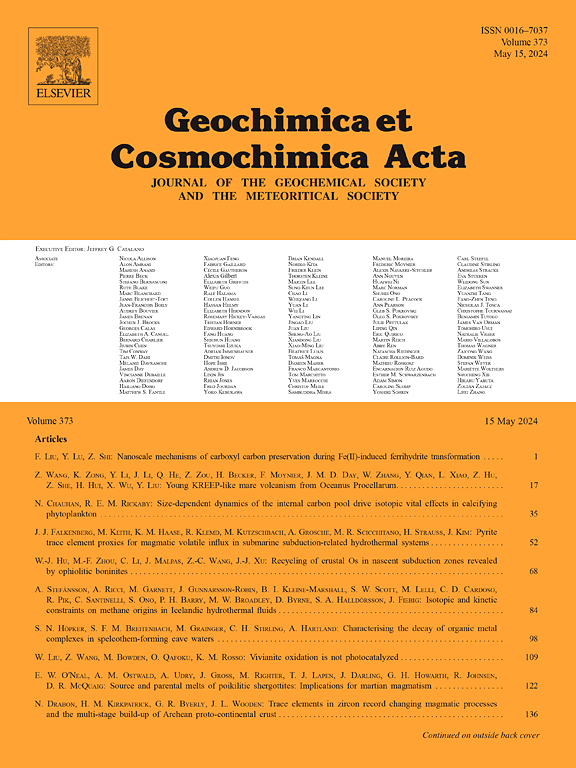变质沉积盆地中黄铁矿-磁黄铁矿脱硫反应的化学和同位素特征
IF 4.5
1区 地球科学
Q1 GEOCHEMISTRY & GEOPHYSICS
引用次数: 0
摘要
在渐进变质过程中,硫通过黄铁矿到磁黄铁矿的脱硫反应释放出来。这一过程被认为为变质流体提供硫和金属,可能有助于造山带金矿床的形成。因此,对这一反应的更深入了解有助于揭示变质流体中硫、金和其他金属在进变质过程中的流动性。我们提出了一种新的多硫同位素结合微量元素的原位研究,重点研究了结构约束的黄铁矿到磁黄铁矿的脱硫反应。这种反应被详细地记录下来,沿着一个递进的巴罗维亚变质场梯度——从黑云母到石榴石、橄榄石和硅线石岩带——记录在Pontiac群变质沉积层序中,该层序与阿比提比省南部及其造山带金矿有断层联系。在黑云母变质带和石榴石变质带的岩石中发现了由磁黄铁矿(Po)取代腐蚀黄铁矿(Py1)的进阶黄铁矿到磁黄铁矿的反应结构。Py1与Po在闪石带中共存,没有明显的结构关系,在硅线质等格栅之后,Py1完全不存在,Po丰富。在所有变质带中,Py1和/或Po均被自面体至亚面体、无包裹体、晚期/逆行黄铁矿(Py2)所取代。硫化物组合的原位微量元素分析表明,随着变质程度的增加,Au、Ag、Te、Bi和Se等金属含量减少,与Py1逐渐被Po取代有关。砷和钴在Py2中保存富集,而Ni富集于Po中,Cu重分配到黄铜矿中。原位多重硫同位素分析表明,Py1和Po之间的δ34S位移为−0.1‰±0.9,Δ33S位移为+0.06‰±0.17,没有可分析区分的分馏关系。结果表明,脱硫反应产生的H2S在黑云母、石榴石和橄榄石带均保持Py1的δ34S-Δ33S特征。对硫化物的结构和化学演变的详细研究突出了脱硫在金属迁移中的作用。黄铁矿与磁黄铁矿的反应是提供硫、Au、Ag、Te、Bi和Se的有效机制,如果与流体的释放和变形同步,则通过地壳调动Au。本文章由计算机程序翻译,如有差异,请以英文原文为准。
The chemical and isotopic characterization of the pyrite to pyrrhotite desulfidation reaction across the metamorphic gradient of a metasedimentary basin
During prograde metamorphism, sulfur is released through the pyrite to pyrrhotite desulfidation reaction. This process is believed to supply sulfur and metals to metamorphic fluids, potentially contributing to the formation of orogenic gold deposits. A deeper understanding of this reaction can therefore help unravel the mobility of sulfur, gold and other metals in metamorphic fluids during prograde metamorphism. We present a novel in situ study of multiple sulfur isotopes combined with trace elements, focused on the texturally-constrained pyrite to pyrrhotite desulfidation reaction. This reaction is documented in detail along a prograde, Barrovian metamorphic field gradient − increasing from the biotite through the garnet, staurolite, and sillimanite zones − recorded in the Pontiac Group metasedimentary sequence, which is fault-bound to the southern Abitibi Subprovince and its orogenic gold deposits. The prograde pyrite to pyrrhotite reaction texture, where pyrrhotite (Po) replaces corroded pyrite (Py1), is identified in rocks from the biotite and garnet metamorphic zones. Py1 and Po coexist in the staurolite zone without a clear textural relationship, and past the sillimanite isograd, Py1 is completely absent with Po in abundance. Py1 and/or Po are replaced by euhedral to subhedral, inclusion-free, late/retrograde pyrite (Py2) in all metamorphic zones. In situ trace element analysis of the sulfide assemblage reveals a decrease, with increasing metamorphic grade, in metal contents such as Au, Ag, Te, Bi, and Se, associated with the prograde replacement of Py1 by Po. Arsenic and Co are preserved and enriched in Py2, while Ni is concentrated in Po, and Cu is redistributed to chalcopyrite. In situ, multiple sulfur isotope analyses show no analytically distinguishable fractionation (δ34S shift of −0.1‰ ± 0.9 and a Δ33S shift of +0.06‰ ± 0.17) between Py1 and Po. These results indicate that the H2S produced by the desulfidation reaction retains the δ34S-Δ33S signature of Py1 across the biotite, garnet, and staurolite zones. This detailed examination of the textural and chemical evolution of sulfides highlights the role of desulfidation in metal mobility. The pyrite to pyrrhotite reaction can be an efficient mechanism for supplying sulfur, Au, Ag, Te, Bi and Se, and if synchronous with the release of fluids and deformation, mobilizing Au through the Earth’s crust.
求助全文
通过发布文献求助,成功后即可免费获取论文全文。
去求助
来源期刊

Geochimica et Cosmochimica Acta
地学-地球化学与地球物理
CiteScore
9.60
自引率
14.00%
发文量
437
审稿时长
6 months
期刊介绍:
Geochimica et Cosmochimica Acta publishes research papers in a wide range of subjects in terrestrial geochemistry, meteoritics, and planetary geochemistry. The scope of the journal includes:
1). Physical chemistry of gases, aqueous solutions, glasses, and crystalline solids
2). Igneous and metamorphic petrology
3). Chemical processes in the atmosphere, hydrosphere, biosphere, and lithosphere of the Earth
4). Organic geochemistry
5). Isotope geochemistry
6). Meteoritics and meteorite impacts
7). Lunar science; and
8). Planetary geochemistry.
 求助内容:
求助内容: 应助结果提醒方式:
应助结果提醒方式:


